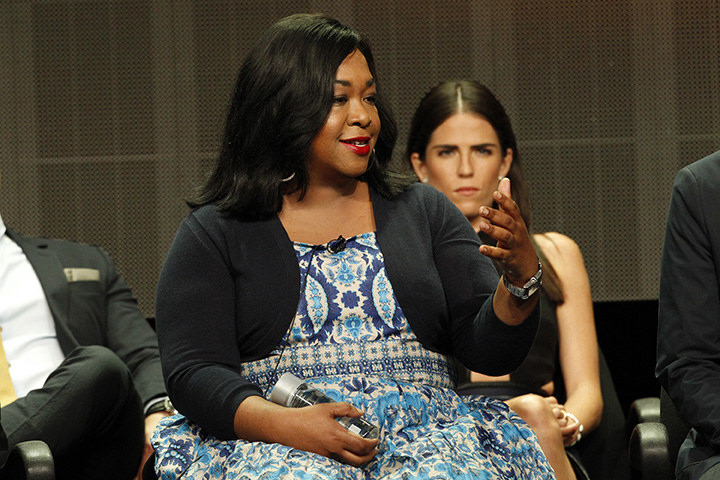Shonda Rhimes: A Champion of Racial and Gender Diversity in American Television

Image: Shonda Rhimes by Disney/ABC Television Group via Flickr/CC BY-ND 2.0.
Since 2014, the Twittersphere has gradually familiarized itself with the hashtag “TGIT.” The abbreviation, which stands for “Thank God It’s Thursday,” was coined by ABC and cleverly refers to the previous 3-hour block of cable television that was dominated solely by Shonda Rhimes’ shows (the scheduling will return in 2017). The timeslot is comprised of “Grey’s Anatomy,” “Scandal,” and “How to Get Away with Murder” episodes, which millions of fans eagerly await on a weekly basis. As of 2015, screenwriter, producer, and director Shonda Rhimes boasts a $60 million net worth, a striking figure which is higher than that of most of her male (and white) competitors. She is amongst the highest paid black women in the entertainment industry; her monetary earnings are a reflection of her talent and innovative contributions to the television industry.
Thanks to Rhimes, Thursday night television will never be the same: TGIT exemplifies both the artistic and social good that can come from expanding diversity in television. In order to fully understand the extent of her impact as a black female creative, one must be aware of the heavily whitewashed condition of American visual entertainment industries. Thus, the pivotal importance of TGIT cannot be overstated; in a cinematographic world that features an embarrassingly low proportion of minority characters, Rhimes has achieved a truly representative and diverse range of characters through Non-Traditional casting and a steadfast dedication to inclusivity.
The entertainment industry has historically placed the experiences of black women at the periphery of screenwriting. Rhimes’ shows demonstrate the diversity that exists amongst black women, illustrating a breadth of experiences, external and internal characteristics, and behaviors. In a world that has been so receptive to the marketability of the “welfare queen,” “ghetto girl,” and “mammy” archetypes, the decision not to incorporate token characters is the more groundbreaking and ultimately rewarding creative choice. Tokenism has become commonplace in American media, particularly within television and film, as this industry, riddled with structural sexism and racism, is dominated by white men. Thus, an overwhelming amount of the narratives are centered on one experience: that of the cisgender, heterosexual white man.
Rhimes has utilized her influence to create minority female characters (across all three shows) who lend a voice to the millions of fans that they represent. For instance, “Scandal” and “How to Get Away with Murder” feature strong black female leads. Additionally, many of the main characters of “Grey’s Anatomy” are women of color. These female characters are unapologetically ambitious, occupy “nontraditional” positions in the professional world, and are highly educated. They also explore their sexual and romantic identities with the men (and women) of their choosings.
Rhimes’s portrayal of these women is what matters: emotionally complex, highly intelligent, and financially successful, the women of color in Rhimes’s TV shows bring fresh perspectives to TV screens across the United States. They are universal characters who embody traits that are almost exclusively associated with white people.Typically, when minority characters are part of a plot, their sole purpose is to supplement the leading (white, male) character, rather than to have their own stories told. Additionally, these characters are often relegated a minimal role that stems from their respective ethnic or racial background, and reduces them to stereotypical attributes and storylines. Rhimes’s viewers, however, are graced with characters who, as commendable women of color, are not peripheral or strictly defined by their respective ethnicities and gender. Rather, Rhimes depicts their individuality and emphasizes their personal struggles and talents, a phenomenon which is scarce in pop culture.
Despite her consistently strong and powerful portrayal of female characters, Rhimes does not understate the vulnerability or raw emotion that these women are capable of as they inevitably face adversity and hardship. In illustrating the emotional and professional dynamics of these women, Rhimes debunks the commonly held notion that women must be stoic in order to thrive in competitive environments. Black female characters Olivia Pope, Annalise Keating, and Miranda Bailey (among others) exemplify this truth. These characters are emblematic role models for young black girls and women who have grown painfully accustomed to trying, and failing, at seeking representation in pop culture. These characters’ relatability also strongly resonates with black women whose individual identities are usually overshadowed by either their womanhood or their blackness (or both). That is not to say that these factors are not important, as it is crucial to acknowledge the ways in intersectional statuses are in conversation with one another and understand the greater social or historical implications of overlapping oppression.




